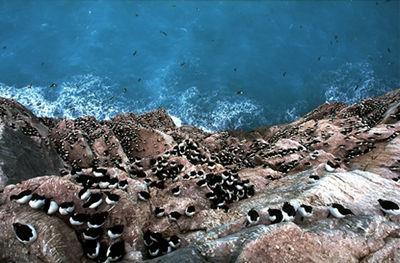Browse "Animals"
-
Article
Molluscan Resources
Although Canada's coastline is extensive and contains many diverse molluscan species, the resource is economically relatively small. In 1995 nearly 200 000 t valued at $114.5 million were taken.
"https://d2ttikhf7xbzbs.cloudfront.net/media/media/75b80a2e-5358-4b29-877d-cf3ed69aa9f5.jpg" // resources/views/front/categories/view.blade.php
https://d2ttikhf7xbzbs.cloudfront.net/media/media/75b80a2e-5358-4b29-877d-cf3ed69aa9f5.jpg
-
Article
Monarch Butterfly
The monarch (Danaus plexippus) is a species of butterfly best known for its migratory habits. Sometimes called the wanderer butterfly, its annual migration is unlike that of any other insect found in North America. During Canadian summers, the monarch butterfly is normally found in every province except Newfoundland and Labrador, and is abundant wherever its host plant milkweed grows. Due to a decline in milkweed among other factors, the monarch butterfly is an endangered species. Still, its large size, orange-and-black colouration, and slow, sailing flight make it a familiar sight across most of Canada.
"https://d2ttikhf7xbzbs.cloudfront.net/Monarch/MonarchMilkweed.jpg" // resources/views/front/categories/view.blade.php
https://d2ttikhf7xbzbs.cloudfront.net/Monarch/MonarchMilkweed.jpg
-
Article
Moose
Moose are the largest living member of the deer family (Cervidae). Four subspecies are found in Canada: the Alaska/Yukon moose (Alces alces gigas), the shiras moose (Alces alces shirasi), the western Canada moose (Alces alces andersoni) and the eastern Canada moose (Alces alces americana). They live in every province and territory except Prince Edward Island. Often considered a symbol of Canada, the moose is featured on Ontario’s provincial coat of arms.
"https://d2ttikhf7xbzbs.cloudfront.net/media/media/82d06bf1-25ff-46ee-8ff5-93dd73cf05c4.jpg" // resources/views/front/categories/view.blade.php
https://d2ttikhf7xbzbs.cloudfront.net/media/media/82d06bf1-25ff-46ee-8ff5-93dd73cf05c4.jpg
-
Article
Mosquito
The mosquito (Spanish for "little fly") is a fragile, long-legged fly of the order Diptera, family Culicidae. Over 3,500 species are known worldwide and at least 82 are found in Canada. Often considered a nuisance to humans because of their itchy bites, it is the females that feed on the blood of other animals. Both sexes feed on plant fluids such as nectar. Most of the woodland species with which Canadians are familiar belong to the genus Aedes. These species are found throughout Canada and are recognizable by their alternating white and black colour, and slender, pointed abdomens. They are present in large numbers soon after winter’s end and on spring and summer evenings. The comparatively small northern house mosquito (Culex pipiens) is commonly found indoors in early spring and late fall, and is distinguished by its size and its blunt-tipped abdomen. Canada boasts the second oldest fossilized mosquito ever found. It is preserved in 76.5–79.5 million-year-old amber from southern Alberta.
"https://d2ttikhf7xbzbs.cloudfront.net/media/media/7861af71-7a87-4136-9077-7718fd7a1bf3.jpg" // resources/views/front/categories/view.blade.php
https://d2ttikhf7xbzbs.cloudfront.net/media/media/7861af71-7a87-4136-9077-7718fd7a1bf3.jpg
-
Article
Moth
Moths are distinguished from butterflies by having threadlike or feathery antennae. Most are nocturnal. They vary in size from adults of some leaf miners with wings spreading little more than 3 mm to the Asian atlas moth, spreading 20 cm.
"https://d2ttikhf7xbzbs.cloudfront.net/media/media/380673b7-8db1-4be5-b284-6764c9a0030d.jpg" // resources/views/front/categories/view.blade.php
https://d2ttikhf7xbzbs.cloudfront.net/media/media/380673b7-8db1-4be5-b284-6764c9a0030d.jpg
-
Article
Mountain Beaver
Mountain Beaver (Aplodontia rufa), most primitive living member of order rodentia. Unlike true beaver, mountain beaver has no close living relative.
"https://d2ttikhf7xbzbs.cloudfront.net/media/media/13135da2-3365-4bf9-a1a9-6e9f43465d36.jpg" // resources/views/front/categories/view.blade.php
https://d2ttikhf7xbzbs.cloudfront.net/media/media/13135da2-3365-4bf9-a1a9-6e9f43465d36.jpg
-
Article
Mountain Goat
The mountain goat (Oreamnos americanus) is an even-toed, hoofed mammal of the cattle family (Bovidae), derived during the ice ages from the primitive Asiatic goat-antelopes.
"https://d2ttikhf7xbzbs.cloudfront.net/media/media/5ca6cc93-bd85-45b3-9e91-65f7b54979bc.jpg" // resources/views/front/categories/view.blade.php
https://d2ttikhf7xbzbs.cloudfront.net/media/media/5ca6cc93-bd85-45b3-9e91-65f7b54979bc.jpg
-
Article
Mountain Sheep
The mountain sheep is a highly successful, medium-sized, even-toed mammal (see Artiodactyla) of the cattle family (Bovidae), genus Ovis.
"https://d2ttikhf7xbzbs.cloudfront.net/media/media/e6c21935-1be8-4c52-bca9-0d86db5d7f2c.jpg" // resources/views/front/categories/view.blade.php
https://d2ttikhf7xbzbs.cloudfront.net/media/media/e6c21935-1be8-4c52-bca9-0d86db5d7f2c.jpg
-
Article
Mouse
Mouse, common name for several rodents of suborder Myomorpha, 13 species of which are found in Canada.
"https://development.thecanadianencyclopedia.ca/images/tce_placeholder.jpg?v=e9dca980c9bdb3aa11e832e7ea94f5d9" // resources/views/front/categories/view.blade.php
https://development.thecanadianencyclopedia.ca/images/tce_placeholder.jpg?v=e9dca980c9bdb3aa11e832e7ea94f5d9
-
Article
Murre
The term murre refers to 2 species, common murre (Uria aalge) and thick-billed murre (U. lomvia), the largest extant members of the auk family.
"https://d2ttikhf7xbzbs.cloudfront.net/media/media/17e7b4cc-ada0-4552-8cd2-fc0fab422f8f.jpg" // resources/views/front/categories/view.blade.php
https://d2ttikhf7xbzbs.cloudfront.net/media/media/17e7b4cc-ada0-4552-8cd2-fc0fab422f8f.jpg
-
Article
Muskellunge
Muskellunge (Esox masquinongy), large, predaceous, soft-rayed freshwater fish occurring naturally only in eastern North America.
"https://d2ttikhf7xbzbs.cloudfront.net/media/media/8909e2d0-1e60-45fb-9182-1ed2097d6bcd.jpg" // resources/views/front/categories/view.blade.php
https://d2ttikhf7xbzbs.cloudfront.net/media/media/8909e2d0-1e60-45fb-9182-1ed2097d6bcd.jpg
-
Article
Muskox
Muskox (Ovibos moschatus), shaggy, horned Artiodactyl of the cattle family (Bovidae); occurs naturally only in Canadian arctic tundra (mainland and Arctic Archipelago), Alaska and in Greenland.
"https://d2ttikhf7xbzbs.cloudfront.net/media/media/3a709b78-b386-493f-a455-f16fe201283d.jpg" // resources/views/front/categories/view.blade.php
https://d2ttikhf7xbzbs.cloudfront.net/media/media/3a709b78-b386-493f-a455-f16fe201283d.jpg
-
Article
Muskrat
Muskrat (Ondatra zibethicus), fairly large rodent common throughout much of North America
"https://d2ttikhf7xbzbs.cloudfront.net/media/media/32e05840-f732-477f-a6ac-fb872c43589a.jpg" // resources/views/front/categories/view.blade.php
https://d2ttikhf7xbzbs.cloudfront.net/media/media/32e05840-f732-477f-a6ac-fb872c43589a.jpg
-
Article
Mussel
The mussel is a bivalve (hinged shell) mollusc of either the marine order Mytiloida or the freshwater superfamily Unionacea.
"https://d2ttikhf7xbzbs.cloudfront.net/media/media/7f00d523-6521-4a0d-bc8b-6d4f3971d383.jpg" // resources/views/front/categories/view.blade.php
https://d2ttikhf7xbzbs.cloudfront.net/media/media/7f00d523-6521-4a0d-bc8b-6d4f3971d383.jpg
-
Article
Narwhal
The narwhal, perhaps best known for its spiralled tusk, is a whale living in Canada’s arctic waters.
"https://d2ttikhf7xbzbs.cloudfront.net/media/Twitter_Cards/narwhal.jpg" // resources/views/front/categories/view.blade.php
https://d2ttikhf7xbzbs.cloudfront.net/media/Twitter_Cards/narwhal.jpg
